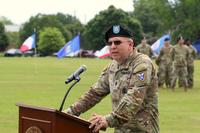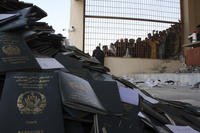After Barbara Dyer of Chisago City, Minn., died at age 86 in 2019, her family buried her at the Fairview Cemetery in Lindstrom.
Four years later, her family gathered again as Dyer’s brother, U.S. Marine Corps Sgt. Arthur Ervin Jr., was laid to rest at the National Memorial Cemetery of the Pacific in Honolulu, Hawaii — even though he died 75 years before his sister at age 22 during World War II on July 5, 1944.
It was a long-awaited service — with full military honors — and Dyer’s family wished she could have lived long enough to witness this patriotic sense of closure.
Instead, Dyer had spent her life wondering if her brother’s remains would ever be found, identified and returned. She died with those questions still unanswered.
“It broke my heart that …” said Dyer’s daughter, Nita Kay Gay (who also goes by Nita Kay), pausing for composure.
“… It was emotional … the question was always lingering in her head … but, the job was done in both Barbara and Arthur’s honor.”
Not forgotten
Until his body was finally identified, Ervin was one of the thousands of military personnel still missing from World War II. Currently, the lost or unidentified totals more than 74,000, according to the the Defense POW/MIA Accounting Agency (DPAA).
To put that number in perspective, it’s roughly equivalent to the population of Lakeville.
It’s a scale of loss much larger than those missing from other conflicts, including more than 5,000 from the Korean War and more than 1,500 from the Vietnam War.
While some of the lost will likely never get to come home — such as those who died at sea — there are many whose remains have been identified in recent times, especially thanks to technological advances.
In Ervin’s case, the doggedness of volunteer researchers and the persistence of family members were also key in moving the process along to finally bring this Marine home.
With these combined efforts, Ervin became one of the 166 service members identified during the fiscal year of 2022. In 2023, 158 were accounted for; during this fiscal year, which ends in September, 109 more people have had their missing cases resolved, according to the DPAA, which is tasked with accounting for the lost.
“There are so many missing from wars and conflicts, our job is unfortunately never going to be done,” said Sean Everette, a spokesperson for the DPAA. “But we will never give up trying to find them and bring them back home to their families.”
A researcher’s personal connection
It was Ervin’s case that led Geoffrey Roecker of Glen Falls, N.Y., to found Missing Marines, an award-winning and incredibly detailed initiative and website (missingmarines.com) dedicated to preserving the stories of missing service members.
“I’ve been at it since 2011,” Roecker said.
His initiative also provides research support to multiple MIA recovery organizations and to families hoping to learn about their military ancestors.
This includes the family of Ervin, who shared a connection with one of Roecker’s ancestors: Ervin’s platoon leader, 1st Lt. Philip Emerson Wood Jr., is Roecker’s first cousin, twice removed.
“Geoff deserves a lot of credit,” said Kay. “This never would have been resolved without his help.”
“She downplays her role, but she did a ton of work,” Roecker replied of Kay.
Kay’s uncle and Roecker’s cousin were friends as well as comrades; friends and comrades who died together.
In July of 1944, Ervin and Wood were members of Company A, 1st Battalion, 24th Marine Regiment, 4th Marine Division, which the DPAA describes as part of the invasion force of the island of Saipan in a larger effort to capture the Mariana Islands from Japan.
From his research, Roecker learned that the Marines were trying to rescue displaced civilians on July 5, 1944. But then, Lt. Wood was hit by a sniper.
As Wood, mortally wounded, cried out, Ervin rushed forward to help him — and, while doing so, was fatally shot by enemy fire.
“He was likely dead before he hit the ground,” Roecker wrote on Missing Marines.
But what happened to Ervin’s body?
That’s been the question that Roecker spent 11 years trying to answer.
X-64
“Sgt. Ervin’s case is a particularly weird one,” Roecker said recently.
He mused about the mystery in a blog post on Memorial Day 2018.
“Arthur Ervin was buried without any means of identification,” he wrote. “Through a clerical error or simple incompetence, he was listed as ‘missing,’ his remains declared ‘unknown,’ and buried under an anonymous stone in Manila.”
Roecker credits a fellow researcher, Ted Darcy, who helped him locate the site in 2011. It seemed like a relatively simple case to crack, given all that was already known about the battle, the dead and the buried.
“He said, ‘I think we can solve this one right away,'” Roecker recalled.
Not quite.
But, Roecker says, after an investigation including dental records, diagrams, data and DNA, it was believed that an unidentified service member known as X-64 was Ervin.
DNA
He wasn’t X-64 to Dyer; to her, he was “Big Brother.”
Technically, they were half-siblings: Their mother, a widow, was raising her three sons — including Arthur — on her own before remarrying and having two more children, including Barbara Dyer.
Dyer was just 7 years old when “Big Brother” enlisted in the military from their then-home state of Texas in June 1940, according to Missing Marines; by October, he had joined the Marine detachment of the Naval Air Station, Pearl Harbor.
Dyer was 11 when her family learned her brother had been killed in action. She didn’t talk about the loss much, but in her later years, she renewed the search to bring Big Brother home.
“She was not so good with the internet, but she found out how to contact someone and they did send her a DNA kit,” Kay recalled.
Eventually, the family learned that a DNA sample from a male relative was needed; it took time to reach out — and convince — a male cousin in California to get involved, Kay says.
During their search for a conclusion, the family learned more about Ervin’s life as well as his death.
“When I began helping my mother, a friend had found out about the Missing Marines site,” Kay said. “From it, I learned more about my mother’s family than she had ever told me.”
In fact, Ervin’s life story on the site — helped along with interviews, military records, family photographs, newspaper clippings and more — is as detailed as a novella, stretching back to describe the history of Ervin’s parents as well as his own backstory.
The story begins:
“Arthur B. Ervin, Junior was six months old when his father died in the mines …”
The effort inspired Kay.
“It was just amazing, all the information he had,” she said. “It motivated me to move forward.”
Through Missing Marines, the family learned how their Marine survived the Japanese attack on Pearl Harbor on Dec. 7, 1941 — and how he matured during this time and was given a second chance after allegedly running afoul of the law.
“The day Pearl Harbor was attacked,” Kay wrote in an email to the Pioneer Press, “Arthur was in the (brig) and in the process of being dishonorably discharged. After volunteering to dig up bombs that had been dropped but didn’t yet explode, he had a follow-up court date. To his surprise, he was offered to join the Marines again based on his volunteerism and work ethics.
“He went on to earn two Purple Hearts and the Navy Gold Cross. Even a Good Behavior ribbon.”
During this long process of searching and researching, though, Kay’s mother died. Soon after, COVID-19 hit.
“The government pretty much shut down,” Kay said.
Finally
The phone call that the family had been waiting for since 1944 — 78 years — finally came in 2022.
“They called and said, ‘We have a match,'” Kay recalled of the phone call from the military. “They said, ‘We’ve identified him.'”
Her reaction?
“I cried,” she said.
One of the first people she alerted was Roecker. He was also invited by the family to the funeral in Hawaii, which was held in October 2023.
Later, he wrote about it in a poem-like post on the Missing Marines page on Facebook:
Twenty-one shots rang out. Ospreys thundered overhead. Taps sounded.
(You can’t not tear up if the bugler knows what they’re doing,
and by god this one did.)
For about five minutes,
I told what I knew about Arthur.
It wasn’t everything. It will never be everything. But —
It was an ending.
Of a life story, and a life quest.
Arthur’s where he needs to be —
shouting distance, at least, from three who died with him;
Wood, Knight, and Hester.
And we who live,
who never thought this day would come,
enjoyed a day in the Hawaiian sun
with him.
A memory on a mantel
On Friday — the 80th anniversary of Ervin’s death — his 13-year-old great-niece, Lilly, reflected on her family’s journey from Saipan to Chisago City to Honolulu:
“I felt honored to be part of Arthur’s funeral,” she said in a text message. “It was an amazing experience.
“I was also so happy to see Mom accomplish this. She worked for years trying to find Arthur for Grandma and often cried hitting roadblocks.
“I didn’t realize just how big this was until the actual funeral … to see someone buried as a hero and receive the honors he did was amazing.”
Now some of those honors are framed in a shadow box, including a folded U.S. flag and Ervin’s military medals. The box is displayed on the fireplace mantel of the lake home where Kay lives with her husband and two of their children in Chisago City.
This home was also the homestead of Dyer and her late husband, who moved here after they retired, so it feels right to keep Ervin’s keepsakes in a prominent spot.
“She used to say, ‘I wonder if we’ll ever find out, I still wonder what happened to my brother,'” Kay said. “I’m glad we have closure, but I certainly wish it had happened before she passed.
“But I know they were reunited in Heaven.”
©2024 MediaNews Group, Inc. Visit at twincities.com. Distributed by Tribune Content Agency, LLC.












